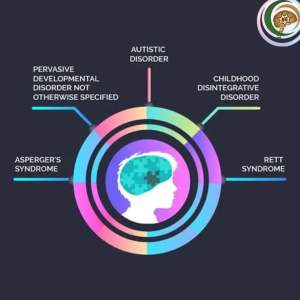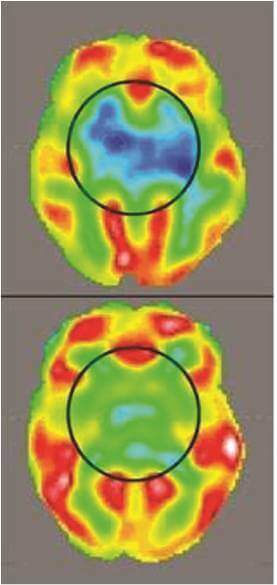treatment
Autism
A. WHAT IS AUTISM SPECTRUM DISORDER?

WHAT ARE THE TYPES OF AUTISM SPECTRUM DISORDER?
Persistent challenges ranging from severe to mild deficit in social communication and interaction, across a number of contexts, are the characteristics of Autism Spectrum Disorder which covers following conditions under its purview:
- Asperger’s Syndrome or people also call it Asperger’s disease
- Pervasive Developmental Disorder not Otherwise Specified
- Autistic Disorder
- Childhood Disintegrative Disorder
- Rett Syndrome
- phenomenon is called pica and is generally seen in a moderate to severe form in children with autism.)

Types of Autism Spectrum Disorder (ASD)
SYMPTOMS OF AUTISM SPECTRUM DISORDER
Children cannot outgrow autism, but research has revealed that autism treatment such as early intervention, involvement, and analysis can lead to increased independence and a better quality of life.
Some of the signs and symptoms of autism are as follows:
- Inability to communicate effectively using non-verbal behaviour and body language like expressions, postures, gestures, and eye contact
- Impaired ability in developing and maintaining peer relationships
- Inability to initiate or participate in conversations
- Slow or impaired development of spoken language
- Repetitive behavior such as twirling or rocking is considered obsessive by some
- Excessive attachment to material objects and reduced human connections
- Inability to connect with one’s own name
- Heightened sensory responses that can cause sensitivity to loud noises or discomfort with the sensation of touch, etc.
- Shortened attention span
- Self-infliction of pain
- Aggressive behaviour towards others like biting, scratching, pulling others’ hair, throwing objects etc.
- Appetite for inedible and non-nutritive items like chalk, paper, sand, paint, dirt (This phenomenon is called pica and is generally seen in a moderate to severe form in children with autism.)

Symptoms of Autism Spectrum Disorder (ASD)
B. STEM CELL THERAPY FOR AUTISM
Even though autism is a complex neurodevelopment disorder, several researchers have come together to comprehend the reasons as to why autism develops and its after effects on the brain.
OBJECTIVE RADIOLOGICAL EVIDENCE OF IMPROVEMENT AFTER CELL THERAPY IN A CASE OF AUTISM
The use of autologous bone marrow has shown major clinical and objective radiological improvements in children with autism. The treatment is easy, safe, and effective as it aims at neurological repair. It gives a new lease of life to the children and restores the lost connection with society.
New approach: How stem cells work in autism treatment
The two key pathologies linked with autism are lack of oxygen supply to the brain and immune degeneration. These factors are directly linked to the slow functioning of the brain. Additionally, an imbalance in brain activity can lead to formations linked with autism.
Research and doctors are working on regenerative therapy using cells as a prospective therapy for children showing signs of autism. The whole concept is that the stem cells should have the capacity to add different cells and structure specialized cells from the mother cell. These cells can help repair the affected neural tissue at the molecular, structural, and functional levels. They get to the core of the neuropathology of autism with the help of paracrine disciplinary functions. It is able to regulate cell differentiation, tissue and organ repair, and anti-inflammatory actions.

THE NEUROGEN OUTCOME IN AUTISM
At NeuroGen BSI, one of the best Autism Treatment Centres, has effectively treated over 1800 people through Cell Therapy in India. They have published the world’s first clinical study on the effect of stem cells on autism in 32 patients in the International Journal “Stem Cell International.” The path breaking results observed in this study have demonstrated the safety and efficacy of Cell therapy.
After the successful completion of cell therapy (as a treatment for autism and other neurological and developmental disorders), Neurogen BSI patients have shown remarkable improvements in various aspects. The behaviour patterns that are observed in children with autism (such as hyperactivity and engaging in stereotypical and repetitive motor mannerisms) have decreased significantly. Immense improvements are also seen in their sensory aspects and motor activities. Several parents have also reported that the concentration and attention span of their children are much better than before.
THE OVERALL IMPROVEMENTS THAT ARE SEEN IN PATIENTS AFTER CELL THERAPY
- Reduction in self stimulatory behaviour
- Improvement in eye contact
- Improvement in speech
- Improvement in communication skills
- Improvement in social interactions
- Reduction in aggressive behaviour
The medical results of the autism treatment patients treated to date with cell therapy at NeuroGen BSI show that 91% of these patients showed an overall improvement on the Clinical Global Impression II (CGI-II) scale. Symptomatic improvements included 70% improvement in eye contact; 60% initiated socializing; 56% initiated social smiling; 55% started maintaining peer relationships; self-stimulating behavior decreased in 55%; 54% reduced echolalia (repetitive) speech; 72% showed reduced hyperactivity, 66% showed reduced repetitive motor mannerisms; and 48% showed reduced aggressive behaviour.
These functional enhancements that have been seen in our patients can be co-related with the improvements in brain metabolism as well, which are observed in the PET-CT (Positron emission tomography-computerized tomography) scans of the patients.
Link to publications on cell therapy as autism treatment: publications
TRADITIONAL TREATMENT
The traditional methods of autism treatment can be categorized as nonmedical and biomedical treatments. Nonmedical interventions include behavioural and educational approaches along with sensory and communication with other therapies. Biomedical treatments include diet modification, treatment of the gut, immune system regulation and more.


